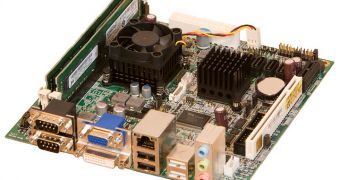AMD's Fusion APU has really managed to take the world by storm when it was officially released a couple of weeks ago, and in order to keep the media spotlights onto it, AMD has decided to also reveal the first APU units targeting the embedded market, namely the G-Series. The new G-Series consists of 1 or 2 x86 “Bobcat” CPU cores with 1MB L2 cache, 64-bit Floating Point Unit, reaching operating frequencies of up to 1.6GHz and reaching TDP values of 9W and 18W, respectively.
Moreover, the processing units also sport an array of SIMD Engines, providing DirectX 11 capable graphics with a very good level of 3D and graphics processing, as well as a 3rd Generation Unified Video Decoder and various power management features, including C6 and power gating.
Moreover, they employ DDR3 800-1066 memory with support for 64 bit channel and 2 DIMMs, and occupy a very small space (890 square mm physical footprint, including the AMD Fusion I/O Controller Hub).
“AMD’s commitment is to ensure the game-changing technologies we develop for consumers and the enterprise are also available for the vast and growing embedded market,” said Patrick Patla, corporate vice president and general manager, Server and Embedded Division, AMD.
“Today, we have a record number of embedded launch partners. They are using the unique advancements of the AMD Embedded G-Series APU to develop a brand new generation of highly differentiated, energy-efficient, small form-factor embedded systems that can deliver the vivid visual experience expected in our always-connected world,” Mr. Patla added.
Of course, we're now eagerly waiting to see just how the first embedded solutions built around AMD's G-Series APU will behave in real-life conditions, and especially when pitted against the Atom-based embedded systems, that have been dominating the market ever since Intel officially introduced its low power CPU.

 14 DAY TRIAL //
14 DAY TRIAL //